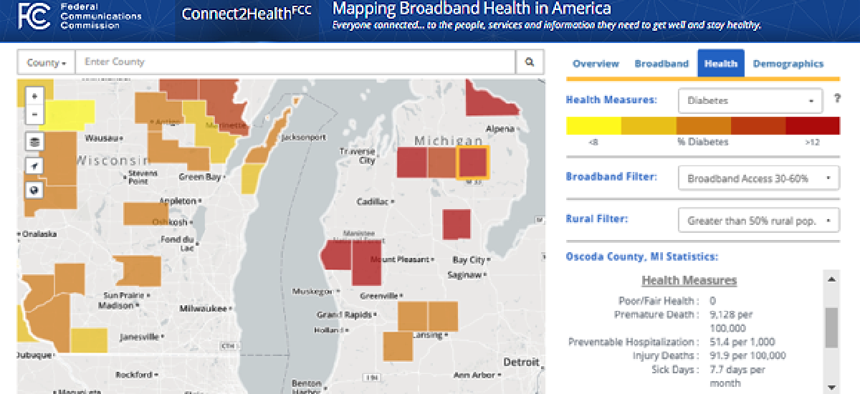Mapping the intersection of broadband and healthcare

The Mapping Broadband Health in America website illustrates the correlation between broadband connectivity and the availability of health care services.
The connection between access to broadband and the availabilityof innovative health care may not be immediately apparent, but a new web-based interactive mapping tool developed by the Federal Communications Commission’s Connect2Health Task Force make the correlations increasingly clear.
Mapping Broadband Health in America lets the public, health officials and government agencies find the intersection between broadband connectivity and health at the national, state and county levels.
“The reality of broadband is that everything it touches is transformative,” FCC Chairman Tom Wheeler said at the Aug. 2 launch event in Washington, D.C. “Yes, broadband is transformative for healthcare, but, no, broadband is not totally available.”
The FCC collects broadband data by county and has opened and integrated that data for the public. The tool is intended to provide critical data and insights about health care’s relationship with broadband so officials can create data-driven policies and provide services to areas in need.
After identifying the areas with connectivity gaps, public and private sector organizations and local communities can work together to develop solutions. “The map can coordinate those kinds of life-saving activities. The map can help focus on areas that need help. The map can direct resources,” Wheeler added.
Users can generate customized maps filtering broadband access, adoption and speed against health measures like obesity, diabetes and physician access in rural or urban areas. The map will show all selected metrics and the intersections.
Data can be downloaded for counties or states in a variety of formats including JSON, XML, SHP, KML or CSV. Application programming interfaces are also available, the FCC said.
Downloaded files can be integrated with external data for customized analyses. For example, a user can generate a map relating connectivity and health metrics to veteran populations.
By integrating broadband and health data, the FCC was able to determine that access to health care, the quality of care and health outcome metrics are very different in connected communities verses digitally isolated communities.
“To use public health parlance, broadband connectivity has become a social determinant of health, along with income, education and rurality,” FCC Commissioner Mignon Clyburn said at the launch event.
The map also illustrates a major connection between rural counties and health issues, with 60 percent of rural Americans living in counties with high chronic disease and little broadband connectivity. Some communities are living in what Clyburn referred to as “double burden” counties, or areas where the highest health needs and lowest connectivity intersect.
The tool is the result of the task force’s “Beyond the Beltway Series.” Members traveled around the country to learn how communities leverage broadband technologies and next-generation communication services to improve access to health services.
For example, the task force witnessed how broadband-enabled health technologies are improving access to mental health care for veterans in Houston where there is a shortage of mental health providers. A public-private partnership in Mississippi also brought broadband, diabetes education and remote monitoring to diabetes patients in an area where broadband was not previously available.
This is the kind of innovation the FCC and its partners hope to push with the mapping tool. “It will help us identify both gaps and opportunities and empower us to construct bridges at the intersection of broadband and health precisely where they are needed,” Clyburn said.
NEXT STORY: Getting started with an agile scrum approach





